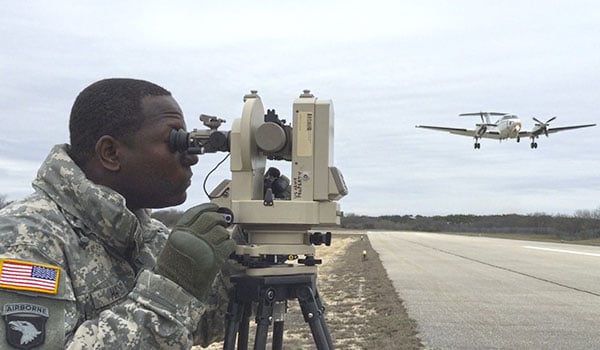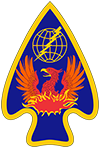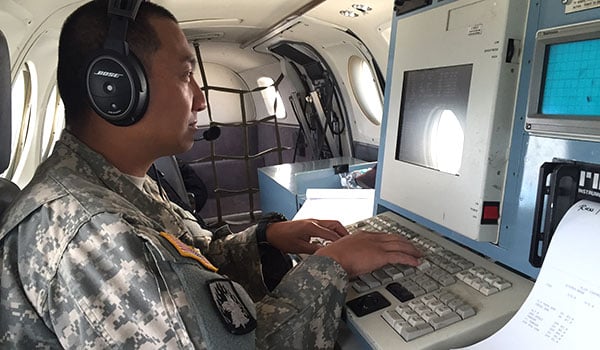
Air Traffic Services / By Mr. Steven M. Haag: Have you ever found yourself in an aircraft cockpit and air traffic control (ATC) contacts you with a flight plan change because of two words “Flight Check?” That’s the call sign for Federal Aviation Administration (FAA) flight inspection aircraft that periodically check airfield services and navigational aids (NAVAIDs) throughout the National Airspace System (NAS) and overseas in support of the nation’s global strategic mission. The FAA’s flight inspection mission is augmented by military formations from the Army and Air Force that are chartered to support U.S. military operations worldwide.

SFC Clifford Linnell checking alignmentson the Automatic Flight Inspection System (AFIS) computer before flight check operations.
The United States Army Air Traffic Services Command (ATSCOM) has the responsibility of flight inspecting Army airfields and tactical air traffic control (ATC) facilities. Flight inspection teams routinely inspect thousands of NAVAIDs and instrument procedures across the acronymic breadth of aerial navigation including ILS, VOR, DME, TACAN, GPS, RNP, RNAV, NDB, various radars, airport lighting, and conducts airborne obstacle evaluations. Each and every public-use instrument flight procedure, whether it is an airway, arrival, approach, or departure, is flight checked by both Army and FAA flight inspection crews for NAVAID support, flyability, obstacles, and overall integrity.
 The Flight Inspection process ensures the reliability of instrument approaches and airway procedures that constitute our National Airspace System infrastructure and the DOD’s international commitments. We accomplish this through the airborne inspection of all ground and space-based instrument flight procedures and the validation of electronic signals that are transmitted from various navigation systems. Airborne inspection of navigational aids is a two-part operation, requiring the skills of highly trained flight crews. The first part is an evaluation of the “signals in space” – the radiation pattern of the navigational aid much like that of a radio station. The second part is to certify the instrument approach procedures that are designed to allow pilots to safely use airport runways in all weather conditions.
The Flight Inspection process ensures the reliability of instrument approaches and airway procedures that constitute our National Airspace System infrastructure and the DOD’s international commitments. We accomplish this through the airborne inspection of all ground and space-based instrument flight procedures and the validation of electronic signals that are transmitted from various navigation systems. Airborne inspection of navigational aids is a two-part operation, requiring the skills of highly trained flight crews. The first part is an evaluation of the “signals in space” – the radiation pattern of the navigational aid much like that of a radio station. The second part is to certify the instrument approach procedures that are designed to allow pilots to safely use airport runways in all weather conditions.
The Process
A staff of senior professional Aviators, Air Traffic Controllers, and ATC Maintenance personnel with over 300 years of combined subject matter expertise leads the ATSCOM Quality Assurance Division. The team task organizes unlike any other Army ATC organization with the technical and tactical skills to coach, teach, and mentor Soldiers during ATC operations to meet Forces Command’s readiness initiatives. The Army flight inspection crew must complete a rigorous FAA training and check ride process to obtain the credentials required to perform the mission. The section’s Airspace Systems Inspection Pilots fly special maneuverers at low altitudes in a C-12D flight inspection aircraft that is equipped with the Automatic Flight Inspection System (AFIS). ATC maintenance crewmembers use this flying laboratory to measure signals and analyze recordings to ensure the facilities meet FAA flight inspection standards. Certified ATSCOM personnel are on the ground to resolve equipment problems and routinely provide technical expertise on ATC systems. The aircrew evaluates suitability of instrument procedures, identifies obstacles that may violate protected flight paths, and provides units with an overall facility status before completing the mission.

SFC Willis Hayes tracks the flight path of ATSCOM’s C-12D at Long Horn assault landing strip, Fort Hood, TX, 10 Mar 2015.
Below: NextGen AFIS mission specialist panel in C-12S at Cairns AAF, Fort Rucker, AL 6 Jul 2016
Evaluations
ATSCOM provides flight inspection assets during Quality Assurance Evaluations (QAE) to assess the safety and effectiveness of installation ATC facilities. This role is vitally important as the scope of ATC operations includes support of Aviation warfighters and civilian aircraft within the NAS and outside the continental United States. Army airfield facilities provide a training base for tactical air traffic controllers and maintenance personnel to obtain facility ratings and equipment certifications. The process includes flight checks of Army installation NAVAIDs, airfield lighting systems, and associated ATC facilities. The evaluations involve airborne analysis of airfield hazards and airspace management procedures. The team conducts surveillance inspections of airfield markings and conditions that may lead to runway incursions. The Senior Commander or airfield authority is provided a detailed report with comprehensive recommendations to mitigate risk and resolve facility issues.
 ATNAVICS Flight Check
ATNAVICS Flight Check
Deployment of the Air Traffic Navigation, Integration and Coordination System (ATNAVICS) by ATC includes the intricate roles of coordinating airspace through letters of agreement, requesting radar and radio frequencies, gathering airfield data, preparing minimum vectoring altitude charts, and developing instrument flight procedures. The unit’s communications and NAVAIDs maintenance team perform equipment certifications in preparation for the unit fly-ability check in order to mitigate risk. The tasks are validated through flight inspection of the unit’s ATC equipment during collective training events, Aviation Resource Management Surveys and contingency operations. The ATNAVICS flight check involves measurement of the Precision Approach Radar (PAR) procedural azimuth, glide path angle, and lower safe limit to within hundredths of a degree. The flight crew assesses air traffic controller performance, radio communications, and airfield lighting systems as they relate to both ATC and Airfield facility operations. The team provides useful feedback to the Commander and provides follow-on training as necessary to bridge gaps in unit programs.
Acquisition Support
The flight inspection team is at the forefront of providing support to the Product Manager for ATC systems to expeditiously field equipment as the Army modernizes tactical and installation systems. The team collaborates with program managers and engineers on equipment block upgrades, and provides technical feedback and recommendations to improve ATC systems. The missions include spectrum analysis of radio communications to assist aviation planners and material developers with addressing radio line-of-site challenges at Army Airspace Information Centers. The team responds to ATC equipment outages and provides maintenance technicians with assistance to calibrate and restore NAVAIDs to service.
The Aircraft
The Army’s only flight inspection airframe is also the first C-12D model to enter the inventory. This legacy aircraft has served the Army well with over 14,000 hours of service dedicated to supporting Army ATC training and the flight inspection mission. Emerging Next Generation aviation programs and changes in Army tactics, techniques, and procedures generated an operational need for a highly deployable and modernized flight inspection aircraft to meet all aspects of our peacetime and Combatant Commanders’ requirements. The Army will take delivery in December 2016 of a (Army’s only FI aircraft) C-12S extended range aircraft that is fully equipped with advanced cockpit flight management systems, aircraft survivability equipment, and state of the art AFIS to meet the dynamic and evolving airspace worldwide. The interoperable aircraft will provide the Army with flexibility to project flight inspection assets into forward deployed areas overseas in support of joint and multinational operations.
Rest assured when you hear the flight check call sign that ATSCOM is doing their part to improve flight safety and Army ATC readiness in a constantly changing airspace environment.
Mr. Steven M. Haag is the Aviation Safety Inspector and Standardization Instructor of the United States Army Air Traffic Services Command at Fort Rucker, AL.







